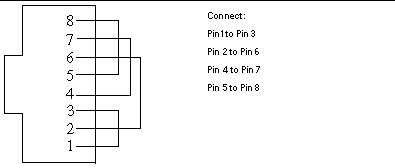
- What is the purpose loopback cable or plug Patch#
- What is the purpose loopback cable or plug software#
- What is the purpose loopback cable or plug plus#
To create a loopback interface, use the following command in a Cisco Router. The command syntax to create a loopback interface is shown below. Loopback interfaces are treated similar to physical interfaces in a router and we can assign IP addresses to them. By default, router doesn’t have any loopback interfaces (loopback interfaces are not enabled by default), but they can easily be created.
What is the purpose loopback cable or plug software#
Loopback interfaces interfaces are always up and running and always available, even if other physical interfaces in the router are down.Ī loop back interface is a software interface which can be used to emulate a physical interface.
What is the purpose loopback cable or plug plus#
Loopback interfaces are used as the termination points for Remote Source-Route Bridging (RSRB), and Data-Link Switching Plus (DLSW+). A loopback interface is always up and allows Border Gateway Protocol (BGP) neighborship between two routers to stay up even if one of the outbound physical interface connected between the routers is down. Loopback interface’s IP Address determines a router’s OSPF Router ID. A loopback interface is not a physical interface like Fast Ethernet interface or Gigabit Ethernet interface.Ī loopback interface has many uses. In addition, to separate by fiber types, single-mode loopback (9/125) and multimode loopback (50/125, 62.5/125) are deployed for the application.A loopback interface is a logical, virtual interface in a Cisco Router. Now it is the most popular loopback with low cost but high performance. Its connector is compliant to IEC, TIA/EIA, NTT and JIS specifications. Another frequently used type is SC fiber optic loopback. Having a low insertion loss, low back reflection and high precision alignment, LC fiber optic loopback is widely used all over the world. LC fiber optic loopback complies with the RJ-45 style interface. Categorized by connectors, fiber optic loopback has SC, LC, MTRJ, E2000 types, etc. You may find that loopback also has different types of optical connectors and fibers. And the looped space is reduced for an easier usage and economic package. As for fiber optic loopback module, the biggest difference is that it has a enclosure to protect the inside cable. When sticking the connectors together, the cable will shape like a loop. It is equipped with two fiber optic connectors on each end of the cable. Fiber optic loopback cable is the traditional fiber optic loopback with a visible cable. Generally, fiber optic loopback cable and fiber optic loopback module are both fiber optic loopbacks. So, what is exactly the fiber optic loopback? By diagnosing the problems of optical equipment, fiber optic loopback provides an easy way to test the performance of the optical network devices. It can be applied to data centers and high-density environments. The difference is that its connector is attached with a push-pull tab which is more flexible for releasing the connector.

Likewise, two optical fibers are wrapped together in a single strand.
What is the purpose loopback cable or plug Patch#
It is basically the combination of uniboot LC fiber patch cable and HD TAB fiber patch cable. You can’t miss this one if you are looking for the extreme space saving solution. In addition, there is an upgraded version of uniboot LC fiber patch cable – HD uniboot LC fiber patch cable. If you want to achieve an easier cable management, this is definitely a good choice. The purpose of this cable is to deliver maximum connectivity performance in a minimal footprint. Uniboot LC fiber patch cable is available in different fiber types of single-mode, OM3 and OM4. The changing of its LC uniboot connector polarity is easy ,which skips the using of tools. The uniboot LC fiber patch cable bundles two fibers in a single patch cord which saves much space for cabling. The transceiver accepts digital signals from the Ethernet device and converts them to optical signals for transmission over the fiber. Many transceivers types, such as SFP, X2, XENPAK, XFP, SFP+, QSFP+, CFP, etc. It is often inserted in devices such as switches, routers or network interface cards which provide one or more transceiver module slot. Transceiver is a self-contained component that can both transmit and receive. While the multimode can be further divided into OM1, OM2, OM3 and OM4. Single-mode patch cables can further be classified into OS1 and OS2.


As for fiber types, there are also single-mode patch cables and multimode patch cables. They have different fiber connectors including LC, SC, ST, FC, MTRJ, E2000, MU, MPO/MTP, etc. Optical patch cables are now widely used in data centers for data transmission. Loopback (also written loop-back) is the routing of electronic signals or digital data streams back to their source without intentional processing or modification.It is primarily a means of testing the communications infrastructure. It is composed of an electrical or optic cable terminated with connectors on the ends.

Overview of Patch Cables and Transceiver ModulesĪ patch cable or patch cord is an electrical or optical cable used to connect one electronic or optical device to another for signal routing.


 0 kommentar(er)
0 kommentar(er)
